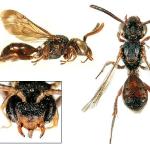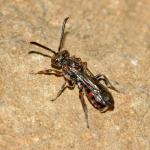With a body length of 4–6 mm this is the smallest of the Nomada species found in the British Isles. The female is unusual in that the gastral tergites are devoid of yellow lateral markings of any kind. In Britain the species is unique in being entirely a cleptoparasite of small Lasioglossum species.
The bee occurs throughout much of southern England from East Kent to West Cornwall, north to Salop, though apparently largely absent from eastern England north of Middlesex. It is scarce in Wales with records from Gwent (Perkins, 1918) and South Glamorgan. There are no records from northern Britain or Ireland. In the Channel Islands it is known from Guernsey (Luff, 1895; Saunders, 1902, 1903) and Jersey (Saunders, 1903).
Widely distributed in central and southern Europe, from France to Turkey; the Middle East (Israel) and North Africa (Algeria and Morocco). Also reported from Japan (Hirashima, 1982).
This species is not regarded as scarce or threatened.
This bee can be expected to occur in the vicinity of the nests of its hosts in a variety of habitats.
Apparently univoltine; end of April to late July.
This diminutive bee is a cleptoparasite of small Lasioglossum species. R C L Perkins (1918) found many fully developed Nomada sheppardana in the burrows of a mixed nesting aggregation of Lasioglossum parvulum (Schenck) and Lasioglossum nitidiusculum (Kirby). There is speculation that other species, such as Lasioglossum morio (Fabricius), Lasioglossum smeathmanellum (Kirby) and Lasioglossum villosulum (Kirby) may also be hosts (Baldock, 2008; Chambers, 1949; Hallett, 1928; Smith, 1876; Perkins, 1892; Spooner, 1931).
An unidentified spurge is the only known flower record.
No data available.
2016



